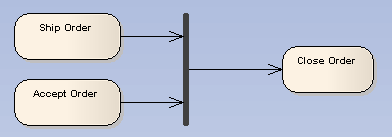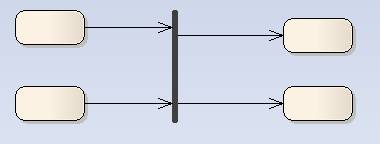|
|
The Fork/Join elements have different modes of use, as follows:
| · | To fork or split the flow into a number of concurrent flows. |
| · | To join the flow of a number of concurrent flows. |
| · | To both join and fork a number of incoming flows to a number of outgoing flows. |
These elements are used in both Activity and State Machine diagrams. With respect to State Machine diagrams, Forks and Joins are used as pseudo-states. Other pseudo-states include history states, entry points and exit points. Forks are used to split an incoming transition into concurrent multiple transitions leading to different target states. Joins are used to merge concurrent multiple transitions into a single transition leading to a single target. They are semantic inverses. To learn more about these individual elements see their specific topics.
Some examples of Fork/Join nodes include:
Fork or split the flow into a number of concurrent flows:

See UML Superstructure Specification, v2.0, figure 255 p. 335.
Join the flow of a number of concurrent flows:

See UML Superstructure Specification, v2.0, figure 263, p. 340.
Join and Fork a number of incoming flows to a number of outgoing flows:

Toolbox Icon
![]()
![]()
OMG UML Specification
Fork
The OMG UML specification (UML Superstructure Specification, v2.0, p. 333) states:
"A fork node is a control node that splits a flow into multiple concurrent flows... A fork node has one incoming edge and multiple outgoing edges."
Join
The OMG UML specification (UML Superstructure Specification, v2.0, p. 338-339) states:
"A join node is a control node that synchronizes multiple flows...A join node has multiple incoming edges and one outgoing edge."




